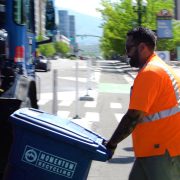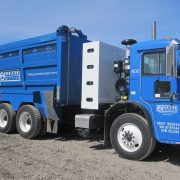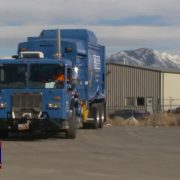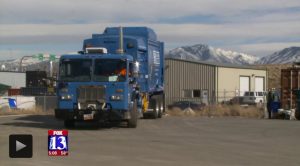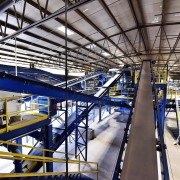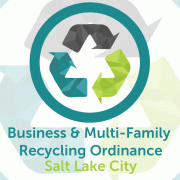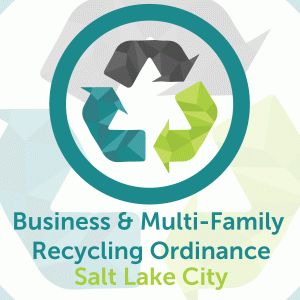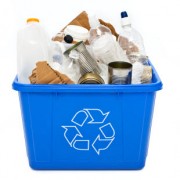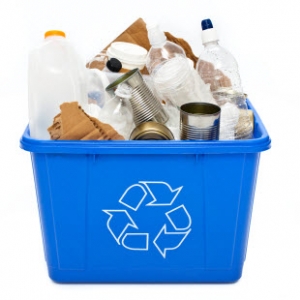Momentum has a New Destination for Mixed Recyclables
As of the start of May 2017, mixed recyclables collected from organizations participating in Momentum Recycling’s business services program have been going to Waste Management’s Material Recovery Facility (MRF) located in South Jordan, Utah. We feel strongly that this new path for your mixed recyclables will ensure greater capture rates while allowing us to have a more constructive dialogue about what can and can’t be recycled.
A quick update about items that are accepted in the mixed recyclables stream: plastic coated containers are okay to place in your blue bins. However, plastic bags and plastic film are still not considered acceptable items and neither is shredded paper (regardless of whether it is contained in bags).
Don’t hesitate to contact us with any questions you might have regarding acceptable items or our new partnership with the Waste Management MRF!
Improving Service & Conserving Fuel Through Route Optimization
The below article was written by Momentum Recycling “Amglassador” Zach Green:
Momentum Recycling started back in 2008 with one goal in mind, to help communities move towards zero waste. This ambitious goal is coming to fruition as more businesses and residents continue to sign up for our recycling services, including glass recycling, mixed recycling and food waste. As Momentum Recycling has grown, we continually strive to find better ways to serve the community and protect the environment (air quality in particular). One way we’re doing this is through the help of route optimization and sequencing solutions.
As residents of the Salt Lake Valley, we’re well aware of air quality concerns and take the health of the environment very seriously. According to UCAIR, vehicles account for nearly 1/2 of winter workday emissions and are the primary source for the air pollutant PM2.5. This harmful pollutant is known to exacerbate the side effects of those living with asthma and COPD1.
What role do routing solutions play? – As a business, serving thousands of customers a week is no small task and performing each route by memory can lead to missed bin pick-ups and inefficient navigation. Through the help of route planning and optimization techniques, we are able to plan the most efficient routes possible to reduce the amount of drive time it takes to perform services and in turn the amount of emissions produced by our trucks (which mainly run on natural gas). Examples of these route changes include not performing U-turns, avoiding left turns (like UPS does as well), avoiding traffic congestion, and setting alerts for hard acceleration. By simply taking the time to implement routing solutions to plan our routes, we’re capable of reducing route time by nearly 35%, resulting in a significant decrease in fuel consumption and total CO2 emissions.
The growth of Momentum Recycling has provided even more opportunities to help communities move towards zero waste. The integration of routing software will not only allow us to better serve our customers but it will also help minimize our carbon footprint. As a business, both of these things are of utmost importance.
Sources:
1. “Air Pollution and Public Health in Utah.” UtahAir – Particulate Matter. Utah Department of Health, n.d. Web. 08 Mar. 2017.
2. “Sources of Emissions.” UCAIR. UCAIR, n.d. Web. 08 Mar. 2017.
Momentum Recycling Awarded Clean Fuels Grant
Grants Awarded to Expand Electric Vehicle Use in Utah
SALT LAKE CITY – Electric vehicle (EV) usage and compressed natural gas (CNG) equipment and infrastructure is expanding in Utah thanks to grants the Department of Environmental Quality’s Division of Air Quality (DAQ) awarded to numerous entities, including this year’s grants awarded to Momentum Recycling, the Utah Office of Energy Development, and Salt Lake City Corporation.
DAQ announced today it has awarded a total of $350,000 in grants from the Clean Fuels Grant Program established by the Utah State Legislature to help three entities purchase EV and CNG vehicles and expand CNG refueling stations along the Wasatch Front.
“I’m very pleased to be able to provide businesses and government agencies with funding to expand alternative fuel vehicles in Utah,” said Alan Matheson, executive director of the Utah Department of Environmental Quality. “This program advances the Division of Air Quality’s on-going effort to encourage cleaner transportation choices that lead to better air quality.”
One of the grant recipients, Momentum Recycling, will use the grant to purchase two natural gas refuse trucks and natural gas refueling equipment. “This project is an example of Momentum Recycling’s long-term commitment to the environment through our recycling and waste reduction initiatives while using clean fuels,” said Jeff Whitbeck, owner of Momentum Recycling.
Those awarded grants are as follows:
- Momentum Recycling: $175,499 for natural gas refueling equipment and $40,875 for natural gas refuse trucks.
- Utah Office of Energy Development: $70,000 grant for 60 EV charging ports to be installed throughout the state.
- Salt Lake City Corporation: $39,626 grant to purchase five EVs and $24,000 to purchase three charging stations.
For more information, visit: www.cleanfuels.utah.gov.
About DEQ: Established in 1991, the Utah Department of Environmental Quality’s (DEQ) mission is to safeguard and improve Utah’s air, land and water through balanced regulation. DEQ implements state and federal environmental laws and works with individuals, community groups and businesses to protect the quality of Utah’s air, land and water. For more information, visit www.deq.utah.gov or call 1-800-458-0145.
Increasing Recycling in Salt Lake City
The below article was written by Momentum Recycling “Amglassador” Ryan Goforth:
Increasing Recycling in Salt Lake City
A new Salt Lake City ordinance that passed on December 8th, 2015 is requiring businesses and multi-family complexes that produce 4 or more cubic yards of waste per week to recycle.
The reason for the ordinance is that businesses and multi-family residences produce half of all waste in Salt Lake City but only recycle 10-15% of that waste. This ordinance capitalizes on a huge opportunity to reduce the amount of waste in our landfills and recover important resources that would otherwise have to be mined from the Earth. Once the ordinance was enacted, waste haulers had 6 months to become authorized, while business and multi-family complexes will have 2 years to start recycling. After those 2 years when recycling among these businesses and residences becomes widespread, it is estimated that more than 20,000 tons of recyclable material will be kept out of Salt Lake landfills. This will help to increase the life of an already stressed system of landfills across the valley.
The ordinance states that these recycling services must be easy to access for customers and tenants so as to make sure that landlords and businesses cannot circumvent the ordinance. However, commercial properties without enough space for a bin can request to be reasonably excluded.
Certain representative groups for commercial properties are concerned about the ordinance and feel that it will put stress on their budget by forcing them to make renovations to their properties, costing them money. Another reason that commercial properties might not be inclined to recycle is because trash disposal rates are very low for Salt Lake City. Low waste disposal costs incentivize people to send more to the landfill rather than to recycle.
However, the long-term savings of increasing recycling would eventually make up for any short-term costs that might incur. Even though tipping fees are relatively cheap currently, they do add up over time, especially with a large amount of waste. When commercial properties are required to recycle, they will send less to the landfill and so be charged less in the long run.
This ordinance is a positive step in the right direction toward creating a more sustainable city and making Salt Lake a more appealing place to live. I hope that in the future Salt Lake will continue to be a champion for recycling and continue the move toward zero waste!
Why Can’t Glass Go in the Mixed Recycling?
The below article was written by Momentum Recycling “Amglassador” Ryan Goforth:
Why Can’t Glass Go in the Mixed Recycling?
One of the most common questions I get when I tell people that I have a degree in environmental studies is “Why can’t I throw glass in with my other recyclables?” The answer I usually give is, “It’s complicated” – but, I gave this answer because before working for a recycling company, I only really knew the basics of why.
Before beginning my internship at Momentum Recycling, I looked into why recycling in Utah is split between glass and everything else. What I found is that it really isn’t all that complicated after all. I found that it makes sense to separate glass from the other mixed recyclables for several reasons.
One of biggest benefits of sorting glass at home is that it reduces the costs of separating the glass later. This is significant because those costs are often later transferred to the producer of that trash, which is us. In sorting our glass out beforehand, we can reduce the cost of our waste. But perhaps more importantly, we can enhance the quality of recycled material in the long run.
When you have a single stream recycling system in which all recyclables go together, the glass will inevitably break apart into tiny pieces. These tiny glass fragments get mixed in with the other recyclables, such as paper, and are essentially impossible to get out (think of a needle in haystack). This leads to a decrease in the quality of materials recovered, which translates to fewer options for potential outlets/products.
Why is this a problem? If a recycling process is able to create products that are of higher quality and can be turned into a larger variety of products, then this decreases the need for virgin materials. With single stream systems, the material that comes out is often not as high of quality as the material that went in. This means that more raw materials must be taken out of the Earth. This costs a vast amount of energy and resources that could be left alone if we just spent the time to sort our recyclables beforehand.
Of course, there are also drawbacks to separating glass out of the waste stream. The main one being that people don’t want to separate their recyclables and so end up sending more to the landfill. However, by limiting the amount of trash people can throw away or by charging them for how much they send to the landfill, you can make sure people will sort their recyclables. People would much rather spend a little extra time sorting than paying more money.
Single stream recycling is at a crossroads. There are so many different recyclable materials used today that material recovery facilities (MRF’s) are unable to effectively sort them all out properly. Glass, plastic bags, and food waste all create problems for recycling systems and we could make these systems considerably more efficient and effective by moving toward multi-stream recycling. Here in Utah, by not throwing our glass into the mixed recycling bin, we can produce much higher quality recycled materials while at the same time capturing more glass for recycling.
